
Use-inspired research: ASU students tackle real-world engineering challenges in health, AI and more
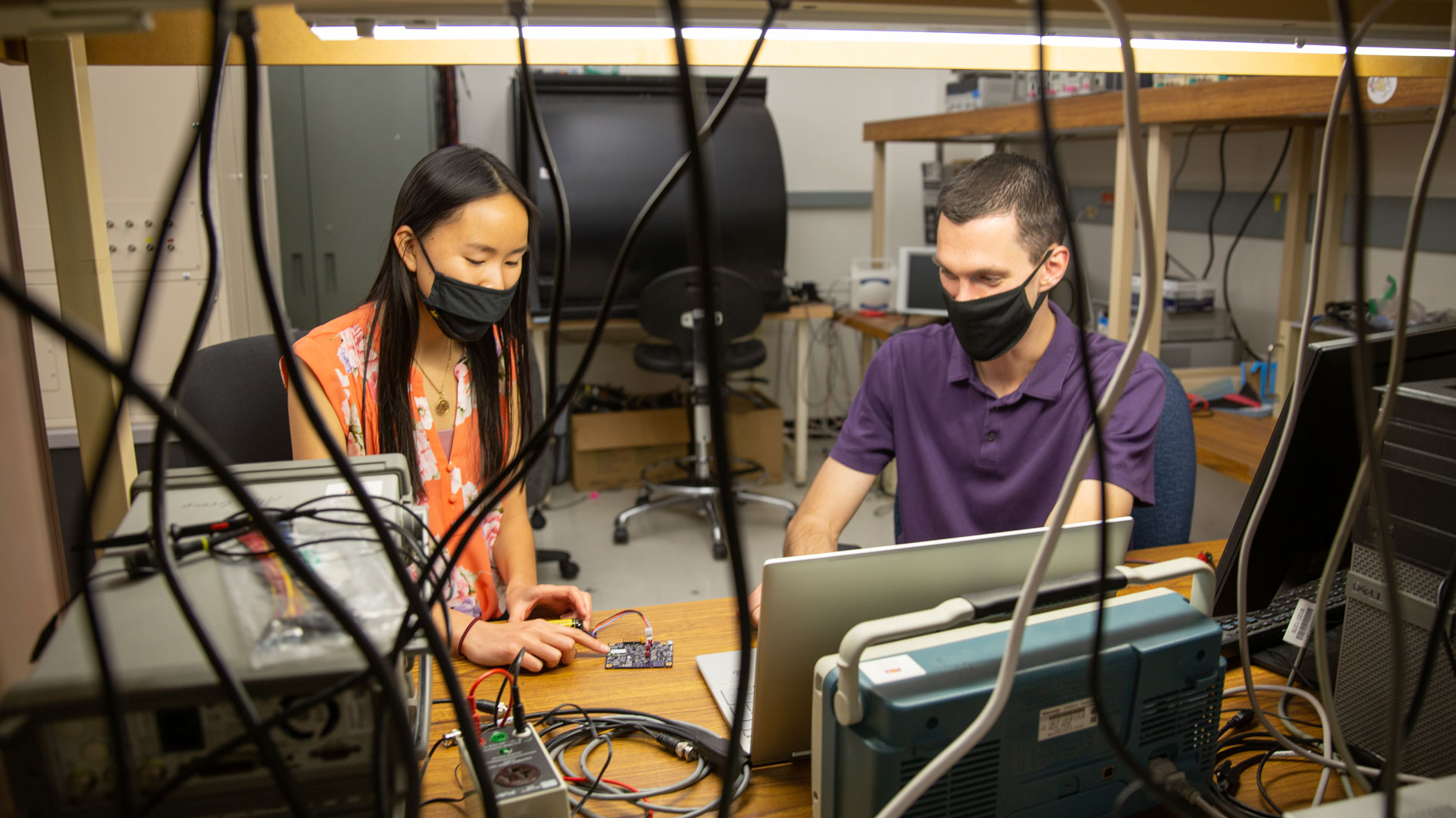
Above: Arizona State University electrical engineering undergraduate student Kylie Welch (left) and graduate student Zachary Lythgoe (right) conduct research in Professor David Allee’s lab. Welch is a student in the Fulton Undergraduate Research Initiative program, known as FURI, where she conducts hands-on research to solve a real-world remote sensing challenge. Photographer: Erika Gronek/ASU
This article is part one of a two-part series highlighting student researchers and faculty mentors presenting at the Spring 2021 FURI/MORE Virtual Symposium on April 16. Read part two. Learn more about the symposium.
Customizable cartilage, robotic swarms, neural engineering and remote sensing are just a few of the areas students in the Ira A. Fulton Schools of Engineering at Arizona State University are researching to gain new ways of thinking.
Conducting research is an excellent way for students to understand how the theoretical knowledge they learn in engineering classes relates to real-world applications. Students can also make an impact in people’s lives with the innovative solutions yielded by scientific research they conduct — even before they start their careers.
There are multiple opportunities for undergraduate and graduate students in the Fulton Schools to address challenges in data science, education, energy, health, security and sustainability.
Students in the Fulton Undergraduate Research Initiative, or FURI, and the Master’s Opportunity for Research in Engineering, or MORE, programs conceptualize an idea, develop a plan and investigate their research question with a faculty mentor over the course of a semester.
Fulton Schools students in the Grand Challenges Scholars Program, or GCSP, can also conduct research for one of the competencies required by the program.
All three opportunities develop students’ skills in innovation, independent thinking and problem-solving to support their future pursuits and careers. And all are invited to participate in the FURI/MORE Symposium, an event near the end of each semester in which students present their research findings in a poster session.
Learn about four Fulton Schools students and one faculty mentor participating in the Spring 2021 FURI/MORE Virtual Symposium. Meet these students and more than 110 other student investigators at the virtual event, open to the public, on Friday, April 16, 1–3 p.m. MST.
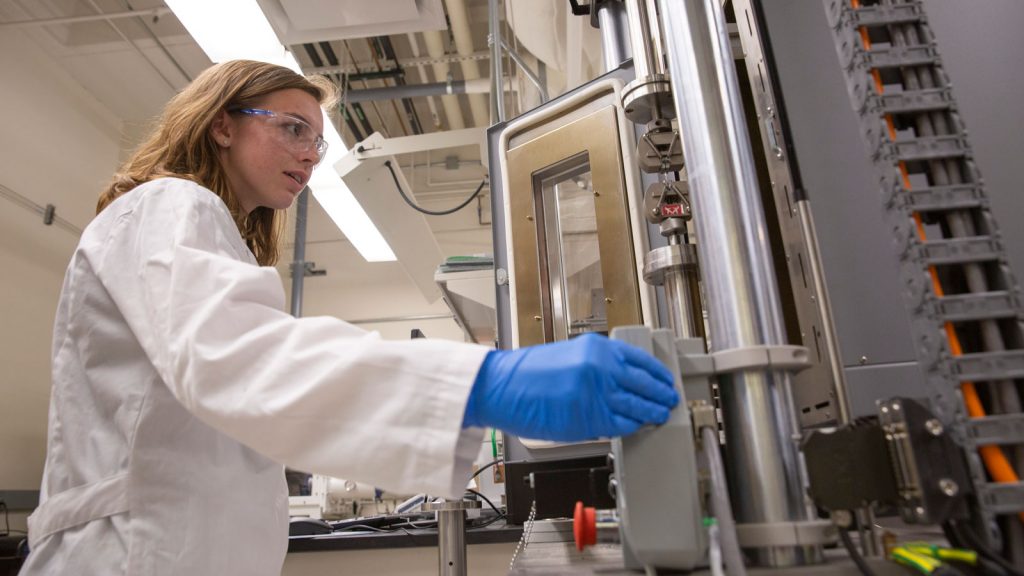
Chemical engineering major Alexis Hocken works in Associate Professor Matthew Green’s lab where she has researched nanoparticles and nanocomposites for biomedical engineering applications since her first year as an ASU student. This photo was taken before COVID-19 pandemic and face-covering requirements went into effect. Photographer: Erika Gronek/ASU
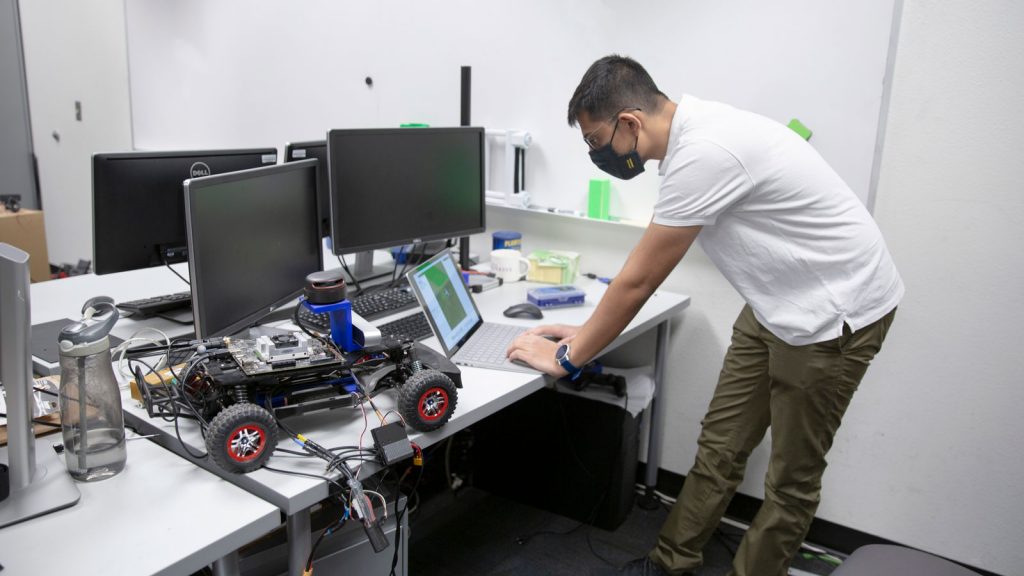
Computer science graduate student Parth Khopkar studies multi-robot swarms in the Master’s Opportunity for Research in Engineering program, known as MORE, with his mentor, Assistant Professor Heni Ben Amor. Photographer: Erika Gronek/ASU
Read more about Alexis Hocken
Alexis Hocken is a chemical engineering senior in the FURI program. She is contributing to the future of customizable cartilage replacements that are more effective and longer-lasting through the design of a new polymer nanocomposite material.
What made you want to get involved in FURI?
I wanted to get involved in FURI because it seems like a great opportunity to continue building my skill set as a researcher. The end-of-semester FURI Symposium is a great way to fine-tune presentation skills and hear perspectives from my peers that I could use in my future work.
Why did you choose the project you’re working on?
I chose the polymer nanocomposite project that I am working on because I am really excited about polymer science and engineering in the context of biological systems. My project involving nanocomposites for cartilage replacements has allowed me to further dive into that passion of mine.
What has been your most memorable experience as a student researcher?
The most memorable experience has been the process of writing a manuscript that will be submitted for publication. Seeing a research project that you designed turn into such an interesting story that can hopefully impact the scientific community is beyond exciting. Furthermore, the writing process has been an incredible learning experience in itself.
How will your engineering research project impact the world?
My FURI research project is laying the framework for creating customizable cartilage replacements. Developing a material that is specifically created for a patient with certain requirements will allow the cartilage placement to not only be more effective but also improve longevity.
How do you see this experience helping with your goals?
FURI has allowed me to build critical skill sets such as problem-solving, data analysis and public speaking. This has served as a foundation for me to become an impactful researcher in my future studies, specifically when I begin my PhD studies this fall at MIT.
What is the best advice you’ve gotten from your mentor, Associate Professor Matthew Green?
The best advice I have received from my faculty mentor has been to utilize every project as an opportunity to grow as a researcher and build your network. Many times it can be tempting to just complete the bare minimum requirements, but if you look for ways to take any project to the next level, it has the potential to lead to a pivotal step in your career.
Why should other students get involved in FURI?
I highly encourage other students to get involved in FURI. This program is set up in a way that makes it easy for those beginning their research journey to get involved. I find research to be such an exciting career path, and FURI gives you a glimpse of what a career in research could look like.
Read more about Parth Khopkar
Parth Khopkar is a computer science graduate student in the MORE program, which presents at the FURI Symposium. Khopkar is teaching multi-robot swarms to better coordinate using reinforcement learning techniques. He was inspired by search and rescue officials saying how this sort of technology could help them better perform their jobs.
What made you want to get involved in MORE?
A couple of my friends were a part of MORE in previous semesters. When I attended their poster presentations at the symposium, I realized that this is something I would love to be a part of.
Why did you choose the project you’re working on?
I have always been fascinated by the promise of robots working together in the future, similar to how humans do now. Coordination with fellow human beings has been the bedrock of human society since the earliest times. This is why I decided to focus on a project in the field of multi-robot coordination.
Another inspiration for my project was an event held at ASU’s Drone Studio in January 2020 where officials from the Arizona Search and Rescue Coordinators Association talked about how having unmanned aerial vehicles (UAVs) in the loop would enable them to get feedback immediately during search and rescue operations and cover more ground than humans can.
What has been your most memorable experience as a student researcher?
One of my most memorable experiences has been presenting in last semester’s symposium. Because it was virtual, my friends and family halfway across the world were also able to attend.
How will your engineering research project impact the world?
My research on multi-robot coordination has a chance to impact many aspects of the world we live in, from underwater robotics to planetary exploration. Something a little closer to home is the use of drones in autonomous search and rescue missions.
How do you see this experience helping with your goals?
The research I do for MORE is also a part of my master’s thesis, so it is already helping my career by supporting my research interests.
What is the best advice you’ve gotten from your mentor, Assistant Professor Heni Ben Amor?
My mentor always says that if you can’t get something to work, just keep reducing the complexity until it does. I have applied this to my work and found that the reduced complexity allows me to better understand the techniques being used and then scale up from there.
Why should other students get involved in MORE?
If you are interested in research or want to know whether research is something that you would like to do for a career, this program is an excellent opportunity to gain research experience. Here, you set the bounds on what you would like to accomplish while being supported by a faculty mentor.
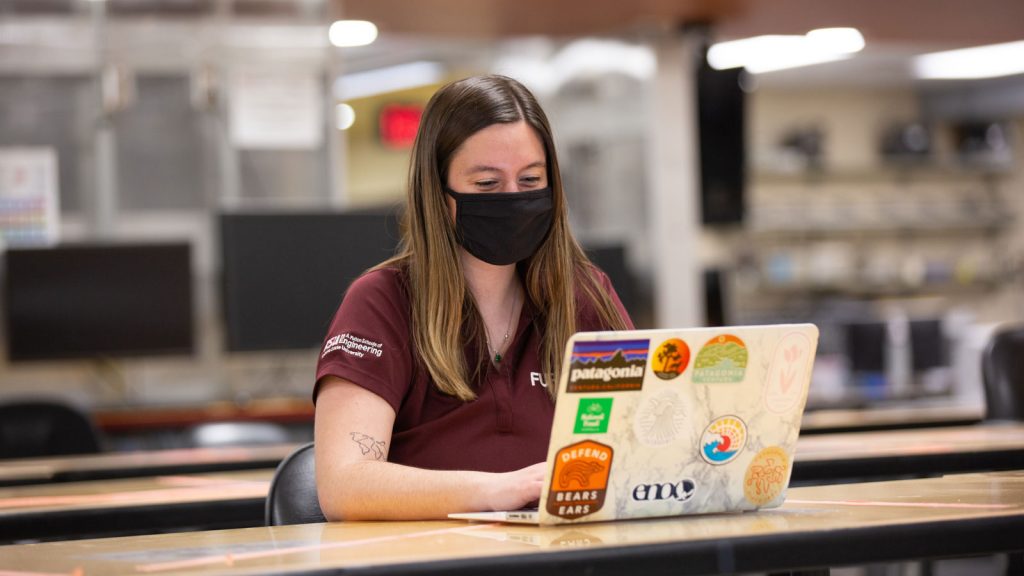
Biomedical engineering major and FURI student Lauren Lossner works in Associate Professor Bradley Greger’s lab. She is researching how certain voltage changes in the brain contribute to epilepsy. Photographer Erika Gronek/ASU

Electrical engineering major Kylie Welch (left) works with Professor David Allee (right) on FURI research related to improving remote sensing with fast, low-power algorithms. Photographer: Erika Gronek/ASU
Read more about Lauren Lossner
Lauren Lossner is a biomedical engineering senior conducting research in the FURI program. With her mentor, Associate Professor Bradley Greger, she is studying the effects of voltage changes in the brain called interictal spikes and their firing rate and action potentials to determine if they contribute to epilepsy.
What made you want to get involved in FURI?
I really wanted to get involved in the FURI program in order to advance my skills in problem-solving, innovation and independent thinking, all of which are necessary for my future pursuits after I graduate from ASU.
Why did you choose the project you’re working on?
I chose to work with Dr. Bradley Greger on my project because I have had family members who have experienced neurological deterioration. Through tragic plights, I realized that I want to be part of the solution to solve and treat neurological and nervous system disorders. This project allowed me to pursue my interest in studying neurological disorder pathology.
What does your research involve?
Interictal spikes — short bursts of the loss of electric charge in neurons between epileptic seizures — have long been used in the diagnosis of epilepsy and the location of seizure onsets. These interictal spikes are thought to arise from changes in membrane voltage from particular cells, although not much is known about the precise role they play in epilepsy. I studied the Hodgkin-Huxley model and revised it to more accurately portray the electrophysiology in a human epileptic brain. In conjunction with this, I also evaluated how local voltage changes due to interictal spikes impact action potential generation and firing using data from ex vivo recording.
Taking an integrated approach to human intracellular data from epileptic patients utilizing micro-electrocorticography and animal models may allow me to determine how the activity of individual neurons and groups of neurons correlate with, and contribute to, interictal spikes.
Thinking through the possible interpretations of underlying mechanisms of epilepsy and what this entails for future epilepsy research has been extremely exciting. As an undergraduate research assistant in a neural engineering laboratory, I have learned how to utilize MATLAB, implement algorithms for sorting data and analyze the response of linear and time-invariant systems to an arbitrary input signal.
How will your engineering research project impact the world?
I hope to gain insight into the generation and propagation of seizures and mechanistically link the activity of individual neurons and networks of neurons with established electrophysiological markers of seizures and epilepsy.
Conducting neural engineering research taught me that I could make a difference in someone’s life. This research could help save the lives of millions of epileptic people around the world. If interictal spike depolarization and action potential inactivation are the underlying pathology of epilepsy, this could lead to advanced diagnostic, therapeutic and treatment options.
How do you see this experience helping with your career goals?
Dr. Greger’s lab has helped solidify my goal to attend graduate school and conduct research in neurorehabilitation. Additionally, from working in a laboratory with post-doctoral and graduate students, I was inspired by everyone’s intelligence and motivation and can see a career path in neurorehabilitation research for myself more clearly than ever before.
Why should other students get involved in FURI?
The FURI program allows you to conduct high-level research on a subject you are passionate about. It’s a great opportunity to work with mentors and professors at ASU who are welcoming, knowledgeable and want to work with students. The program is designed for you to conceptualize an idea, develop a plan and investigate your own unique research question. You get to develop and investigate innovative solutions to real-world, everyday challenges in multiple fields. It’s a great way to get involved and conduct meaningful research!
What else have you gained as a Fulton Schools student?
My experience in biomedical engineering in the Ira A. Fulton Schools of Engineering at ASU has been a great one. I feel confident that I am prepared for productive employment and graduate study in neural engineering. I am confident in my technical knowledge and leadership abilities to address domestic or global issues in human health and am prepared to ethically and responsibly contribute to society by drawing from an integrated, transdisciplinary biomedical engineering education that focuses on sustainability and environmentalism. I am so happy to be a Sun Devil.
Read more about Kylie Welch
Kylie Welch is an electrical engineering junior conducting research in the FURI program. She is working on improving remote sensing applications with her mentor, Professor David Allee. Her research involves fast, low-power algorithms that can improve execution times required to analyze frequencies used in remote sensing.
What made you want to get involved in FURI?
Being able to see how my coursework applies to engineering has always been exciting. After taking more specialized engineering classes, I learned about some interesting topics relating to electric fields and signals. FURI has allowed me to gain hands-on lab experience and apply my coursework to help solve real-world security challenges.
Why did you choose the project you’re working on?
Due to my interests in nature and animals, I chose this project to gain insight on the generation of electric fields and signals in nature. I was interested in how this could be used in the development of remote sensing on low-power devices.
What has been your most memorable experience as a student researcher in FURI?
My most memorable experience in this remote sensing research was when I was able to successfully analyze a digital signal using a fast Fourier transform, or FTT, algorithm. This showed how it is possible to utilize a fast, low-power algorithm for signal processing and analysis.
Have there been any surprises in your research?
I have learned that the development of low-power devices is very useful for security applications. It is surprising to see the increasing need for remote sensing and how there are a variety of uses for fast, low-power signal algorithms.
How will your engineering research project impact the world?
This research will show how mimicking animal mechanisms as alternative, bio-inspired solutions can be used to solve real-world security issues. The insight gained from this research will help in the development of fast, low-power algorithms for use in sensing and object detection.
How do you see this experience helping with your career?
This undergraduate research has enabled me to learn about future technologies within the engineering field. The hands-on experience has allowed me to develop critical thinking skills needed in coursework, internships and my future career.
What is the best advice you’ve gotten from your faculty mentor, Professor David Allee?
Go into a field that you are passionate about and will enjoy working on every day.
Why should other students get involved in this program?
FURI has allowed me to see the connections of my coursework to real-world challenges by researching interesting topics. Connecting with my faculty mentor and other students has helped me develop my current and future career goals.
“Conducting neural engineering research taught me that I could make a difference in someone’s life. … I want to be part of the solution to solve and treat neurological and nervous system disorders. This project allowed me to pursue my interest in studying neurological disorder pathology.”
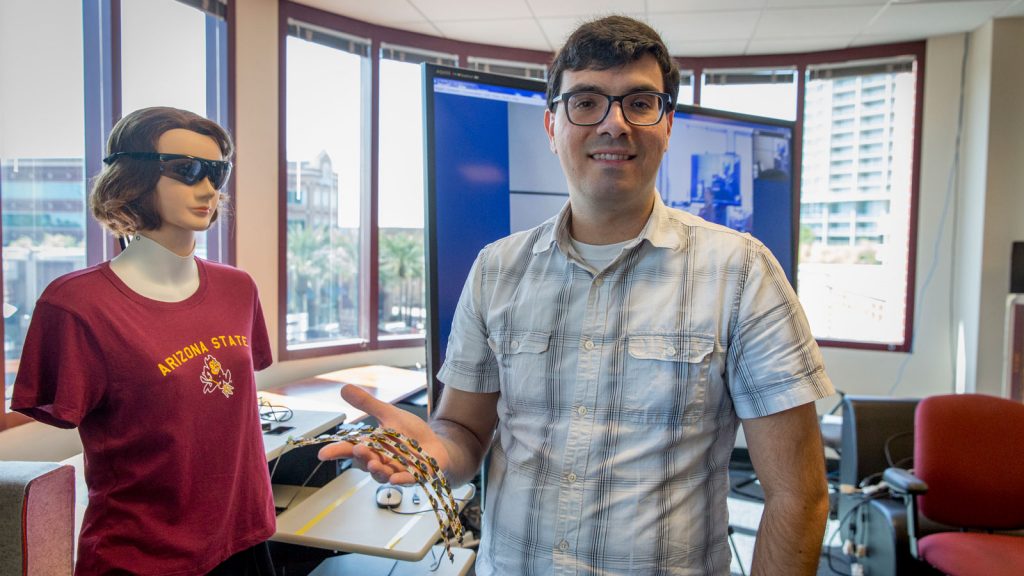
Troy McDaniel, an assistant professor of engineering in The Polytechnic School, mentors FURI and MORE students. He has been a faculty mentor in these programs for almost 10 years. This semester, McDaniel is mentoring two graduate students — Dean Spyres and Shubham Gharat — who are conducting research in the MORE program to help patients get better care and also facilitate social and emotional communication over long distances. This photo was taken before COVID-19 pandemic and face-covering requirements went into effect. Photographer: Nick Narducci/ASU
Read more about Assistant Professor Troy McDaniel
Assistant Professor Troy McDaniel has been a mentor in the FURI and MORE programs for almost 10 years, and he looks forward to mentoring for many more. He sees these programs as valuable opportunities for students and mentors alike to conduct impactful research and believes they set students up for success in their future careers.
What made you want to get involved as a FURI and MORE mentor?
My motivation to participate as a FURI/MORE faculty mentor stems from the purpose and goals of the program. FURI is a springboard to promote research-oriented thinking, a skill critical for our undergraduate students. I encourage my FURI and MORE students to devise a research project from the ground up, develop their budgets and consider broader impacts. These are important skills regardless of your career trajectory in STEM.
What is your favorite part about seeing your students conduct research?
I enjoy watching my FURI and MORE students become increasingly independent as they lead their research projects from inception to public presentation of their results.
How have your FURI and MORE students had an effect on your research?
Most of my FURI and MORE students continue their research projects well beyond the semester time frame. I encourage my students to think long-term and to articulate their vision and goals for the project, whether it be applying for a patent or publishing a conference paper.
Why has the mentor experience been rewarding for you?
My most rewarding experience has been watching the impact the FURI and MORE programs have on students. This is a period in a student’s academic career where his or her trajectory is the most malleable. I firmly believe that FURI and MORE have long-lasting, positive impacts on students’ future careers in STEM.
What advice would you give to students who might be interested in participating in FURI or MORE?
Don’t wait until your final year to apply for the FURI and MORE programs. Identify a faculty member with common research interests and communicate your interest in applying to your mentor as soon as possible.
Why should other faculty members become FURI/MORE mentors?
As a FURI/MORE mentor, you’ll have access to a platform to recruit, support, mentor and impact students as they conduct meaningful research.
Learn more about the student projects for which McDaniel is a mentor.



































